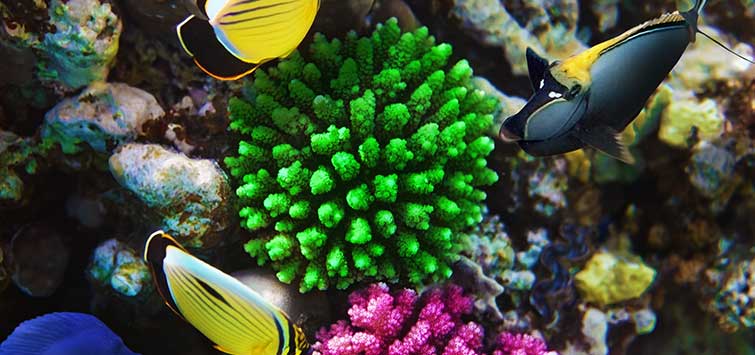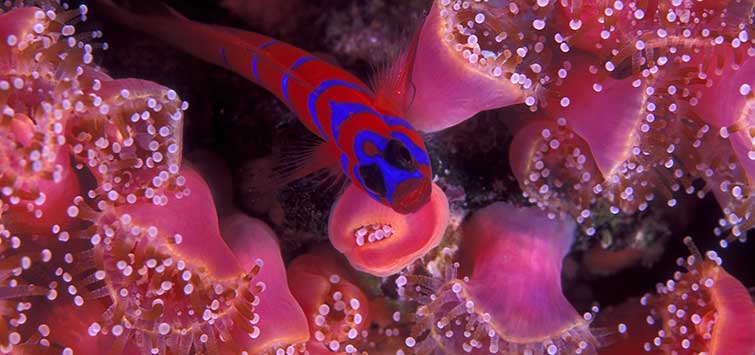From Reef to Retail
Author: Jeremy J. Gosnell
Although reef tanks mesmerize all and serve as windows to the ocean wild, many are unfamiliar with how it all comes together. One marine expert explains the various methods—of varying degrees of sustainability—by which fish are caught, imported, and ultimately brought to your local fish shop.
Gazing into a marine aquarium can captivate anyone’s imagination. It’s amazing to watch as light plays over unique and colorful fish, some of which are so intensely beautiful that one could only wonder how their patterns and shapes ever came to be. The distinctive fish and other animals from all over the world’s oceans are the heart and soul of the marine aquarium hobby. The desire to keep some of Mother Nature’s most exotic and amazing creatures has kept the hobby alive, fueling its growth from humble beginnings into a multimillion-dollar industry.
Most marine aquarists realize that the vast majority of saltwater fish offered for sale have been wild-caught, taken from their home on the coral reef to enter the aquarium trade. In some cases these animals have traveled across the globe to wind up in our aquarium. If we understand the journey these animals have taken, perhaps we can be better attuned to what we, as aquarists, need to provide to keep them healthy.
Many of the fish caught from the wild perish before they even make it into a hobbyist’s aquarium, and many do not last long after purchase. Some of these species are hardy and live for a long period of time when offered the proper care, but other species that are captured and imported are extremely fragile and only thrive under the observation of an experienced and thoughtful aquarist.
Where All Those Marine Aquarium Fish Come From
Marine aquarium fish include species from nearly all areas of oceans throughout the world. Common species like the yellow-headed jawfish Opistognathus aurifrons, Spanish hogfish Bodianus rufus, bluehead wrasse Thalassoma bifasciatum, and Atlantic blue tang Acanthurus coeruleus are Caribbean and tropical Atlantic species. They are collected in areas of Florida and islands throughout the Caribbean.
Rarer and more expensive species such as sohal tangs Acanthurus sohal, purple tangs Zebrasoma xanthurum, combtooth gobies Amblygobius rainfordi, and others come from the Red Sea. The Red Sea is a unique body of water located in the Middle East. Political tensions in that part of the world combined with the individuality of the species are the reasons that animals from this area command much higher prices than species from other oceans. The Red Sea has a much higher density than many regions, with areas reaching a specific gravity of 1.032 and above. Compared to most reef aquariums that are kept at a density of 1.025 to 1.027, the Red Sea is very salty.
Common species such as yellow tangs Zebrasoma flavescens, yellow-eyed kole tangs Ctenochaetus strigosus, and convict tangs Acanthurus triostegus are from the Indo- and South Pacific regions, often collected off Hawai‘i and other islands. Mandarinfish Synchiropus splendidus and most clownfish Amphiprion spp. are imported from the South Pacific in areas like Palau, Fiji, and South Africa. The Solomon Islands and other South Pacific island nations supply a large amount of both fish and coral to the marine aquarium trade, as do mainland Southeast Asian countries. The U.S. represents the world’s largest market for ornamental fish, taking in a staggering 60 percent of all fish exported for the marine aquarium trade. The reefs around Southeast Asian nations are rich in species diversity of both fish and coral, making the region a large world player in the marine fish trade.
How Marine Fish Are Captured
At one point, many marine fish were captured using cyanide and other poisons. These mixtures were crudely used by individuals who did not have the proper training or understanding of their effects on the reef environment or fish health and physiology. The mixture was dumped into the water, and many fish were stunned. They could then easily be netted. The problem was that many of these fish had sustained severe internal damage due to the poison. Also, the surrounding reef structure was ultimately killed. Areas of the Philippines were totally decimated due to cyanide fishing for both the food and ornamental fish trades.
Today’s regulations are tighter, and while cyanide fishing isn’t totally a thing of the past, it is far less common than it was years ago. Many island nations utilize hand-net capture. Here, divers (sometimes free-divers or divers on scuba) go down and capture the fish one (or several) at a time via hand-operated nets. There are no chemicals used, and the fish are taken from the reef in much the same way that we would remove them from the aquarium.
While hand-net capture isn’t the only technique used to attain marine fish, it is one method that helps ensure healthy livestock later down the chain as marine fish make their way to our aquariums. I typically support and frequent retailers who only sell net-captured livestock (or animals collected with other equally safe methods). Reliable fish retailers are able to tell you not only how their fish were captured, but also which region of the world they were captured from. Finding a retailer that is MAC (Marine Aquarium Council) certified can help guarantee that you are purchasing livestock that has not been collected using chemicals or poisons.
The Chain of Custody
The chain of custody of a marine fish typically begins somewhere on the other side of the world. An islander on either an Indo-Pacific or South Pacific island will depart from a small, often crude, dock or harbor with the intent of capturing fish for the marine aquarium trade. With any luck, they utilize hand-net capture techniques and have been trained by either MAC or a responsible importer of marine fish from Europe or the United States. In some cases these islanders return in the afternoon, moving the day’s catch directly into their holding facility or that of an on-island marine fish exporter. In other cases, the islanders spend several days on the reef living off their boat and capturing marine fish.
Responsible exporters train their collectors in little matters that make a huge difference, such as changing the water in the fish’s holding tank (often a glass cup or jar-like container) at least daily to prevent waste buildup. The exporter will quickly know if any collector is not following through, as they will consistently deliver less healthy livestock. Even such small things as teaching the collectors to keep the fish under shade can make a big difference. In many cases these people have transitioned from catching fish for food and need to learn new habits. Once the collectors have returned to the harbor or dock, the fish they have captured are then sold to an exporter.
Once in the hands of a responsible exporter, the animals receive proper care and conditions. They are offered filtered aquarium water that is maintained in a manner that keeps the animals healthy. The purging process then begins. The fish are not fed for at least 24 hours to help minimize the accumulation of waste during transport. It is at this point that the fish are marketed and sold to a marine fish importer, likely either in the U.S., Canada, Japan, or Europe.
Now the fish are packaged (much like an online retailer packages fish for domestic sale) and shipped off to an importer’s facility. Many importers have large facilities in California, since it provides better access to South Pacific regions. The journey is often long and the animals are in transit for 24 or more hours, so they are packaged with plenty of oxygen in the bags. Once they arrive at the importer’s facility, they are examined to make sure the trip has not overly stressed or injured them. They are also checked for parasites, and some importers utilize freshwater baths or chemical dips to prevent parasitic outbreaks. Other methods of controlling parasite problems are ultraviolet sterilization or ozone dosing of the tank water.
More reputable marine fish importers will then implement a 14- to 30-day quarantine period. Some will utilize hyposalinity to maximize the effectiveness of the quarantine. Once this quarantine period has been completed and the staff of the import facility is confident that the fish in their care are healthy, they are offered for sale. In some cases they are sold directly to hobbyists via the Internet, and in other cases they are sold to retail facilities at wholesale prices.
When a fish is shipped to a retailer, a variety of processes can take place. In some cases the retail facility will further quarantine the fish for two weeks or more, and in other cases the fish will be offered for sale immediately. Typically at this point, marine fish find themselves in better care than at the marine fish exporter or importer’s facility. Good marine fish retailers utilize state-of-the-art equipment to keep their charges healthy until an aquarist decides to take them home.
The Good, the Bad, and the Ugly
As you can see, the journey that a marine fish embarks on when it leaves its home reef is long and extensive. This journey can be difficult and leave the animals in a severe state of stress, or it can be relatively easy. This is why it is important to know the sources of your fish and invertebrates.
Overcrowding and unclean conditions at exporters’ or importers’ facilities can lead to parasitic infection and death. Dangerous and harmful capture techniques on the part of collectors can not only kill aquarium specimens before they make it stateside, but also permanently injure them while decimating natural coral reef ecosystems. However, this is where we aquarists come in, first by only patronizing responsible dealers who concern themselves with chain of custody, and second through adequate care of imported animals.
Providing proper quarantine and stress management for new aquarium arrivals is paramount. Since risk of parasitic or bacterial infection is high after this tremendous journey, a quarantine period of at least 21 days can help ensure that your new specimen is diagnosed and treated if needed, but also that the healthy species in your display tank do not become infected. Providing vitamin-soaked and -supplemented foods and researching individual species’ nutritional requirements also help ease the transition from transit to aquarium life. Quarantine also offers the animal with a stress- and competition-free environment to acclimate to its new surroundings. It gives the aquarist easy observation of the fish’s feeding behavior and allows for preparation to provide any special necessities for each individual and to make sure it is feeding well before it has to compete for its meals.
Research before purchasing a species is also very important. There would never be a reason to remove an animal from a natural coral reef if there wasn’t a demand for it. Many species still offered for sale grow too large, are too difficult to feed, or simply cannot adjust to life in an aquarium. These animals are better left on the reef or in the hands of public display aquariums that have enormous tanks and employ a staff of marine scientists.
Moorish idols Zanclus cornutus, orange-spotted filefish Oxymonacanthus longirostris, and various shark species all have reputations of being either too big or too touchy for home aquariums. In addition, species like mandarinfish Synchiropus splendidus have terrible survival records except in the hands of very experienced hobbyists. Still, we often see these gorgeous and unique animals for sale in great numbers at aquarium retailers all over the world.
Responsibility Starts at Home
If you are interested in preserving marine fish species or protecting natural coral reef ecosystems, your most powerful tool—believe it or not—is your consumer dollar. Supporting fish outlets that sell only net-captured and wisely harvested species, and only keeping fish you can be successful with, are responsible actions that work to help keep the marine aquarium hobby from becoming a detriment to Mother Nature.
Researching which nations worldwide practice responsible marine fish harvesting and asking your local fish store just where your fish came from and how they were captured are important steps to limiting reef destruction by unscrupulous collectors.
Mahatma Gandhi once said that, “A nation and its moral progress can be judged by how they treat their animals.” The capture, export, and care of marine fish are extremely important ethical concerns. These amazing animals surprise, astound, and impress us on many levels. We must understand that they have undergone a remarkable journey and have specific care requirements if we want to be successful in this enormously rewarding hobby.
See the full article on TFH Digital http://www.tfhdigital.com/tfh/200909/#pg97

.png?h=595&iar=0&w=2781&hash=5FD5E69473BCC22199FBFA2FB71B6033)



